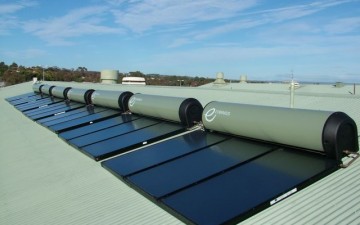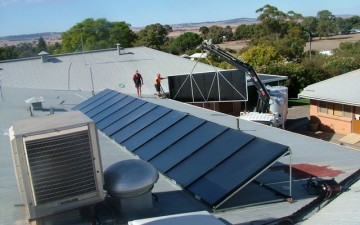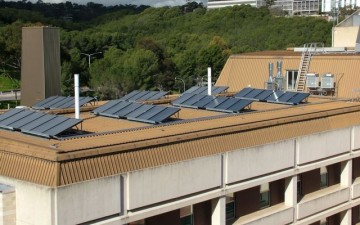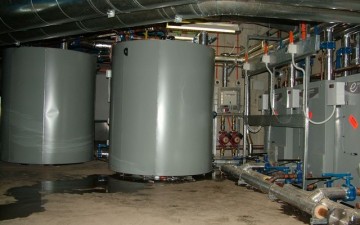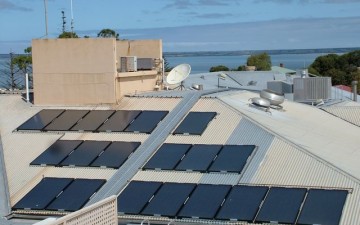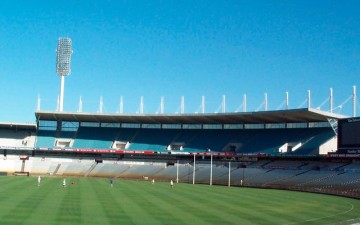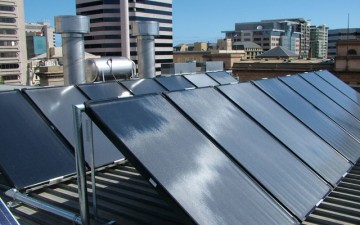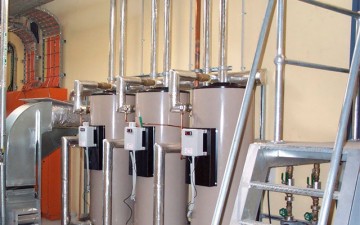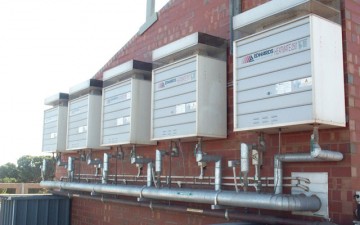Equipment.
Solar Edwards Adelaide have developed a new solar hot water system utilising the Edwards GXC Hot/Warm water cylinder.
The system utilises all the advantages of the Edwards Indirect Heat Exchange hot/warm water systems and the Indirect Heat Exchange solar contribution systems.
The system can be supplied with a Commercial Continuous Flow or Heatmate gas burner back-up, and up to 6 Solar Panels.
The system incorporates an integral ring main return coil to offset the ring main losses, and retains all the advantages of the GXC system of top and front access for all services.
Solar Edwards Adelaide is offering a BMS run/fault status output option for the SEA C2/20, SEA F2/32 and SEA G2/50 pump sets.
The voltage free C/NO/NC contacts will be provided pre-piped within the pan mount of the pump set.
Solar Edwards Adelaide are in negotiations with Contractors for a number of major projects in SA & NT with a high priority placed on energy savings and environmental solutions.
Solar pre-heat through the Edwards Indirect Heat Exchange Systems is a major consideration in these projects with a view to reducing gas consumptions to a minimum and therefore reducing the green-house gas emissions for these projects.
Other systems being considered are the use of condensing boilers to raise the efficiency of the gas boilers up to a 90% to 96%, to achieve an energy saving for the project.
We have designed systems utilising both Solar Pre-Heat and Waste Heat as a primary heat source for hot water generation, which will reduce the energy consumption of the project to almost nothing.
SVpak
Commercial Continuous Flow Water Heater
Technical Data
The Edwards SVpak combines the benefits of mains pressure and continuous flow water heating. Manifolded banks of continuous flow water heaters meet the peak demand period requirements whilst the storage tank provides buffer for peak simultaneous demands.
How it works
The thermostat senses the water in the storage tank and activates the primary pump which in turn activates the continuous flow water heaters. Water is drawn from the bottom of the tank and is returned to the hot water outlet at the top of the tank. When the thermostat senses water in the tank at set point the pump and water heaters are turned off.
Top Down Heating
Edwards SVpak utilises the top down heating principle. This allows the coldest water to be supplied to the continuous flow water heaters for the longest period of time to maximise the recovery rate whilst providing hot water immediately for use. Other systems utilise a traditional return fitting on the storage tank which provides warmer water to the continuous flow water heater. This causes the water heaters to modulate the gas input and reduce the effective recovery rate.
Range
SVpak is available from 1 to 10 continuous flow water heaters with 1 or 2 storage tanks depending on system size. Larger systems are available on application.
Features Include:
- 82% thermal efficiency heat source
- Vitreous enamel storage tank up to 82°C operation
- Large flow 50mm storage tank fittings
- High storage tank delivery rating due to top down heating
- Digital temperature display
- Indoor and outdoor models available
Benefits Include:
- Mains pressure performance
- Reduced footprint
- High recovery
- Redundancy backup
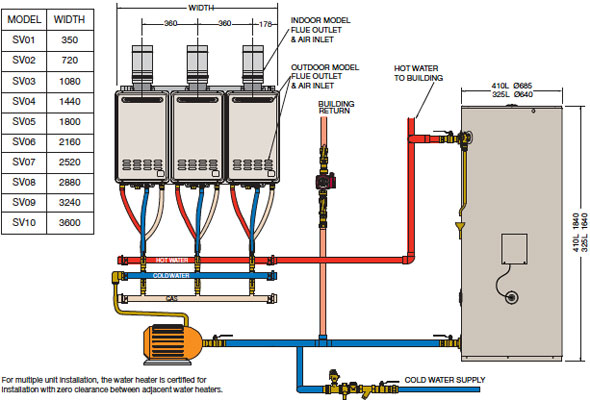
Flat Plate Collectors Verses Evacuated Tube Collectors
Compare Apples with Apples
- Not all solar collectors are created equal
- Similarly, not all evacuated tubes are created equal
- Comparisons should be made against specific products, using appropriate measures
- Before making collector comparisons, a basic understanding of collector science is needed
- Why some collectors work better than others. What’s Hot and What’s Not
Efficiency Misrepresentations
- Beware of efficiency claims made
- For when the collector is at its coldest, this provides the highest efficiency point
- Similarly, efficiency claims shown for when the water is hottest are equally misleading
- Evacuated Tube Collectors perform extremely well at the top (hot) end. If process heating requiring steam generation is required, an ETC is an excellent choice
- Curves for some Evacuated Tube Collectors will show how they outperform flat plate collectors, particularly at the top end
- Depending on which collector is being compared, they can, and if steam generation is your thing, then an ETC is an excellent choice
The Correct Measure
- The appropriate point to measure the collector efficiency is at the average temperature for the water temperature range being considered
- For DHW this is between 15 and 70°C
Other factors to consider
Installation
The recommended angle of inclination for ETC is 40Degrees to prevent hail damage and to optimise performance. This presents aesthetic considerations for architects or the risk of sharp shards of glass if broken. Most roofs in Australia are around 20 Degree to a max of 30 degrees
Frost
Beware of frost tolerance claims. Some claims are made that the system is tested to Australian Standard 2712 for frost tolerance to minus 15 degrees C, without the need for glycol. This implies that a direct system can be used, which is the most efficient means to transfer solar energy into the water. What is not stated is that the test involves a pumped strategy to prevent the collectors from freezing.
This is a standard frost protection strategy, one which ALL direct solar manufacturers employ, to varying degrees of success, regardless of the type of collector employed. Direct system frost protection strategies rely on several factors to ensure collectors are protected from freezing, the primary one being that the pump is actually working, be it due to non failure of a component or power being available. The only true frost protection systems are those containing glycol.
| Edwards Titan | Edwards Australis | ETC | |
|---|---|---|---|
| Description | 2 x Flat Plate | 2 x Flat Plate | 30 x Evac Tubes |
| Gross Area | 4.43m2 | 4.43m2 | 4.35m2 |
| Absorber Area | 3.74m2 | 3.74m2 | 2.4m2 |
| Yearly Ave energy/day (Sydney) | 48.43MJ | 39.42MJ | 30.42MJ |
| MJ/m2(gross) | 10.9 | 8.9 | 7.0 |
| MJ/m2(absorber) | 12.9 | 10.5 | 12.7 |
| STC’s | 24.8 | 21.5 | 21 |
The (ETC) calculator was used for deriving output of evacuated tube collectors. Equivalent data used to calculate Edwards collector output. As can be seen, the yearly average energy output of both of Edwards collectors is greater than that of the ETC. Even when comparing the absorber efficiency. This demonstrates that in typical domestic hot water applications, in Australia, an evacuated tube collector provides no benefit whatsoever.
SPF Testing The Sustainability Institute
Solar Energy – The Big Myth:
Evacuated tube solar panels are more efficient than flat plate collectors – Wrong!"
"Tests carried out on 160+ different solar panels by the internationally acclaimed research organisation Solartechnik Prufung Forschung (SPF) found that the gross efficiency of flat plate collectors was considerably higher than evacuated tube collectors.
"The average gross efficiency of the 120+ flat plate collectors tested was about 70%, while the average efficiency of the 42 models of evacuated tubes was only 49%. In terms of range, the flat plates varied from 51% to 79% while the evacuated tubes varied from 31% to 62%. All but five of the flat plate collectors tested had a gross efficiency greater than 60%."
"How is it that the manufacturers of evacuated tubes can claim their products are more efficient than flat plates?"
"Quite simple really – they compare only the area of the aperture (the bit the sun shines through) of the two types of panel. On average, the aperture of an evacuated tube captures solar radiation more efficiently than the flat plate. There is however considerable variation between different models. Much more significant however is the relationship between the aperture area and the gross dimensions of the panel.
Whereas the aperture of a flat plate collector may exceed 90% of the total area of the panel, on some evacuated tubes it is as low as 52%. As anyone who has looked at an evacuated tube solar collector will know, there is a lot of space between the tubes!
So contrary to the claims of the evacuated tube suppliers, you probably need a larger gross area of evacuated tube collectors to achieve the same heat output as can be achieved with a given area of flat plate collectors."
Source: The Sustainability Institute
Summary
- Evacuated tubes are efficient, especially at the extreme hot end of the temperature spectrum
- However they require more footprint to provide the same output as Edwards collectors.
For general hot water use, a good flat plate collector provides the best balance between footprint and efficiency
Conclusion
At the end of the day, the collector and it’s efficiency is but one factor in designing an effective solar system. Where the collectors and tanks are made is important, back up support for the complete system, including boosters, controllers as well as well documented proposals with data that can be supported are equally important.
We trust the information presented provides a clear understanding of collector technologies to enable you to make an informed choice.

